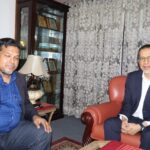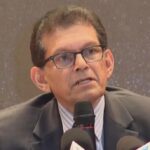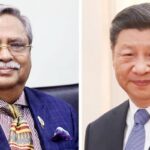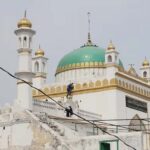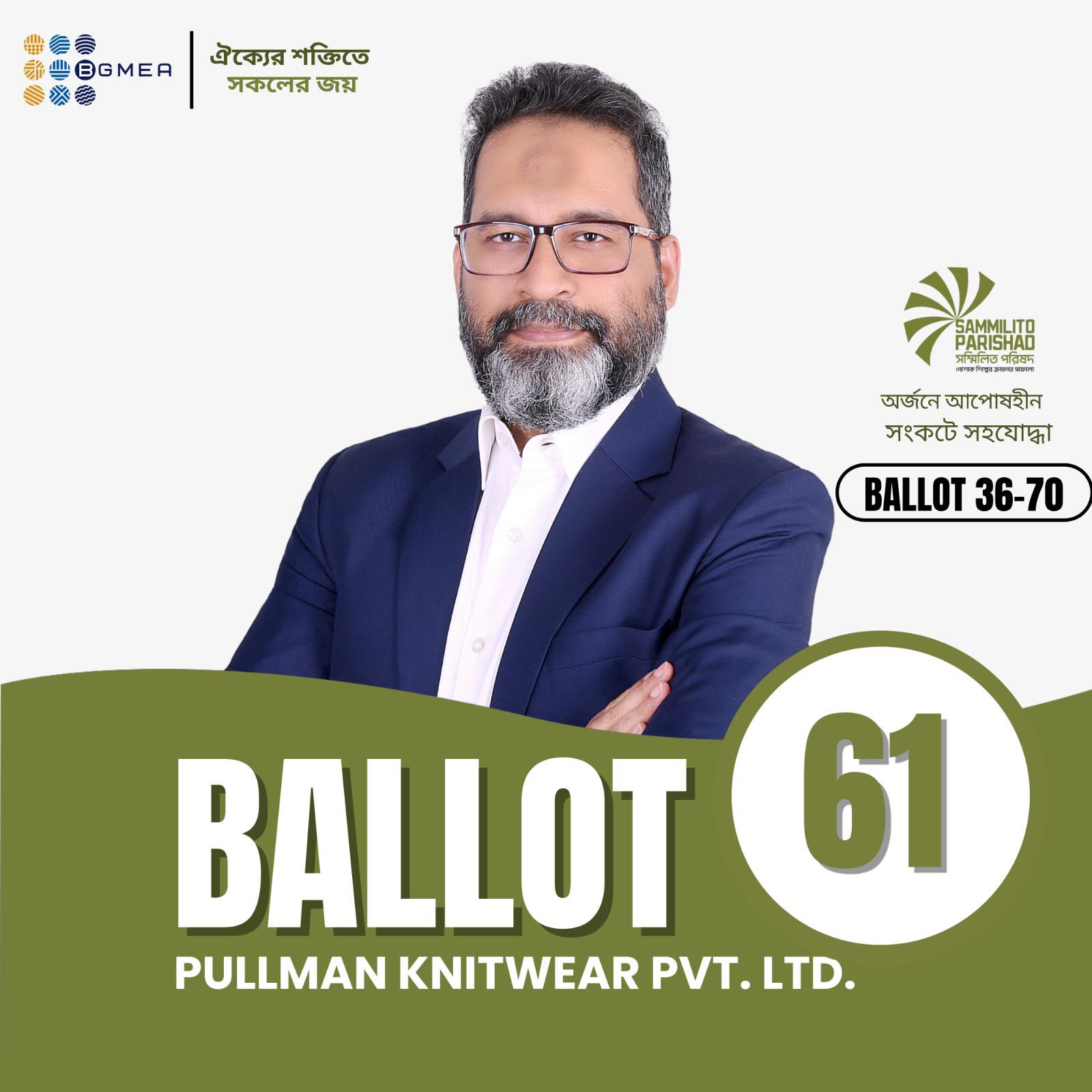
One of my greatest strengths is strategic leadership and I have a clear vision for growth and the ability to align my team around that vision, said Rashedur Rahman Chanchal, one of the Popular Candidates in upcoming BGMEA election. He is contesting from Sammilito Parishad Panel, his Ballot no is 61. Rashedur Rahman is the Managing Director at Pullman Knitwear Pvt. Ltd had an exclusive interview with MM Rahmatullah on Wednesday at Hotel Inter-Continental Dhaka. Here is the full interview for readers.
Daily Moon: Tell us something about yourself.
Rashedur Rahman: “I am Rashedur Rahman, Managing Director of Pullman Knitwear Pvt. Ltd. I have been actively involved in the textile and garments industry for 17 years, with a strong focus on innovation, quality, and sustainability. Under my leadership, Pullman Knitwear has grown steadily by delivering high-quality knitwear products that meet international standards.
I am deeply committed to promoting Bangladesh’s garments sector globally and ensuring our factory operates with efficiency, compliance, and care for our workforce. My goal is to contribute meaningfully to the industry by adopting smart technology, sustainable practices, and a customer- centric approach.”
DM: What are your greatest strengths?
Rashedur Rahman: “One of my greatest strengths is strategic leadership—I have a clear vision for growth and the ability to align my team around that vision. I’m also highly adaptable, which helps me navigate the constant changes in the global apparel industry, from shifting buyer demands to supply chain disruptions.
Another key strength is my focus on quality and compliance. I believe long-term success comes from maintaining high standards and earning trust, both locally and internationally. Lastly, I value people—I invest in building strong teams and maintaining a positive, ethical workplace culture.”
DM: How will the escalating US-China trade war (125% tariffs) impact Bangladesh`s Garments Sector?
Rashedur Rahman: The escalating US-China trade war, marked by a 125% tariff on Chinese apparel, presents both opportunities and challenges for Bangladesh`s garment sector.
Opportunities:
Diversion of Orders: With Chinese products becoming more expensive, US buyers are seeking alternatives. Bangladesh, known for its competitive pricing and quality, stands to gain increased orders.
Market Share Growth: Bangladesh has already seen a 35.95% growth in US apparel imports from 2018 to 2024, indicating a positive trend that could be amplified by the trade war.
Challenges:
Tariff Imposition on Bangladesh: The US has imposed a 37% tariff on Bangladeshi garments, which could reduce competitiveness against countries like India (26%) and Vietnam (46%).
Order Reductions: Some Bangladeshi factories have reported potential order reductions of up to 30% from US buyers due to the new tariffs.
While the US-China trade tensions open doors for Bangladesh to capture a larger share of the US apparel market, the concurrent imposition of tariffs on Bangladeshi products poses significant hurdles.
Strategic negotiations and diversification of export markets may be essential to navigate this complex Landscape.
DM: Why should Voters choose the Shommilito Parishad Panel?
Rashedur Rahman: Voters should choose the Shommilito Parishad Panel because it represents experienced, committed, and forward-thinking leaders who understand the real challenges of our industry. Our panel prioritizes workers` welfare, sustainable growth, strong international relations, and transparent governance. We are not just promising change—we have the capability and track record to deliver it. Up to now, what developments have done in BGMEA, almost 99% done by Sommiloto Parishad. In members of BGMEA there is a great love and affection and sympathy for Sommilito Parishad due to its service to them.
DM: What are present challenges in RMD?
Rashedur Rahman: present challenges in RMD is:
l Interrupted Gas and utilities supply
l Over dependence on the USA and Europe
l Low-Skilled Workforce and Training Gaps
l LDC Graduation and Global Regulatory Challenge
l Weak backward linkage for MMF diversification
l Unfriendly Policies for SME Manufacturers
l High Interest rate and high cost of doing business
l Average Customs Clearance Times for Exports
l Multiple compliance standards and cost
l Weak global positioning on the Made in Bangladesh branding
DM: What are the common problems in the readymade garments sector in Bangladesh and how can we overcome these?
Rashedur Rahman: Common problems in Bangladesh`s readymade garments sector include low product prices from buyers, delayed payments, high dependency on a few markets, lack of innovation, and ongoing compliance and labor challenges. To overcome these, we need to focus on value-added products, diversify export markets, improve worker skill development, push for fair pricing, and invest in automation and sustainable practices. Strong leadership and unified industry representation are also key to tackling these issues effectively.
DM: What are the potential prospects for Chinese investment in Bangladesh resulting from the US- China trade war?
Rashedur Rahman: The escalating US-China trade war, marked by significant tariffs on Chinese goods, has prompted Chinese companies to seek alternative manufacturing hubs to maintain access to key markets.
Bangladesh has emerged as a promising destination for this redirected investment.
A. Rising Chinese FDI: As of September 2024, Chinese foreign direct investment (FDI) in Bangladesh reached $2.67 billion, positioning China as the country`s second-largest investor. Notably, the textile sector attracted $760.14 million, while telecommunications received $322.45 million, indicating a strategic diversification beyond traditional industries.
B. Strategic Manufacturing Shift: The imposition of up to 145% tariffs on Chinese apparel by the U.S. has made Bangladesh an attractive alternative for Chinese manufacturers aiming to circumvent these barriers. Bangladesh`s competitive labor costs and established garment industry infrastructure enhance its appeal.
C. Infrastructure Development: Chinese involvement in infrastructure projects, such as the Karnaphuli Tunnel and the Payra Power Plant, underscores a commitment to bolstering Bangladesh`s logistical and energy capacities, further facilitating industrial growth.
D. Special Economic Zones (SEZs): Initiatives like the Chinese Economic and Industrial Zone (CEIZ) in Chattogram are designed to attract Chinese enterprises. However, delays in operationalizing these zones highlight the need for expedited development to fully capitalize on investment opportunities.
Challenges to Address:
l Regulatory Hurdles: Complex export-import procedures and bureaucratic inefficiencies can deter potential investors. Streamlining these processes is essential to create a more business-friendly environment.
l Infrastructure Bottlenecks: Despite ongoing projects, issues like port congestion and energy shortages persist, necessitating further investment in infrastructure to meet industrial demands.
Bangladesh stands at a strategic juncture to attract increased Chinese investment amidst global trade realignments. By addressing regulatory and infrastructural challenges, the country can position itself as a key manufacturing hub for Chinese companies seeking to mitigate the impacts of the US-China trade tensions.
DM: What`s the 90-day impact of US tariffs on Bangladesh`s RMG sector, and what risk mitigation plans should exporters adopt?
Rashedur Rahman: The imposition of a 37% U.S. tariff on Bangladeshi ready-made garment (RMG) exports, announced on April 2, 2025, has introduced significant challenges for the sector. Although a 90-day suspension was granted on April 9, the uncertainty surrounding future trade relations necessitates proactive risk mitigation strategies for exporters.
Immediate Impacts:
l Export Volume Decline: The elevated tariffs have made Bangladeshi garments less competitive in the U.S. market, leading to potential order reductions and revenue losses.
l Employment Risks: Reduced demand may compel factories to scale down operations, posing threats to employment in a sector that supports millions.
l Market Diversion: U.S. buyers might shift sourcing to countries with lower tariffs, such as India or Vietnam, affecting Bangladesh`s market share.
Risk Mitigation Strategies:
l Diplomatic Engagement: Bangladesh should intensify diplomatic efforts to negotiate tariff reductions or exemptions, emphasizing the mutual benefits of trade continuity.
l Market Diversification: Exploring and expanding into alternative markets, including the European
Union, Canada, and emerging economies, can reduce dependency on the U.S.
l Product Diversification: Investing in the production of value-added and diversified apparel products can attract a broader customer base and mitigate risks associated with specific product categories.
l Cost Optimization: Enhancing operational efficiencies through technology adoption and lean manufacturing can help offset increased costs due to tariffs.
l Strengthening Trade Alliances: Engaging in regional trade agreements and alliances can open new avenues for export and reduce reliance on any single market.
By implementing these strategies, Bangladesh`s RMG sector can navigate the challenges posed by U.S. tariffs and work towards sustainable growth.
DM: How will Bangladesh`s proposed industrial water tax for sustainability affect textile and other water-intensive sectors` production costs?
Rashedur Rahman: Bangladesh`s proposed industrial water tax aims to promote sustainability by charging industries, particularly water-intensive sectors like textiles, for groundwater extraction. While this initiative addresses critical environmental concerns, it also presents challenges for the textile industry, a cornerstone of the nation`s economy.
Impact on Production Costs
l Increased Operational Expenses: Currently, many textile factories in Bangladesh extract groundwater without incurring costs. Introducing a water tax will directly increase operational expenses, especially for wet processing units that consume approximately 250–300 liters of water per kilogram of fabric—significantly higher than the global benchmark of 50 liters per kilogram.
l Capital Investment Requirements: To mitigate the financial impact of the tax, factories may need to invest in water-efficient technologies and recycling systems. While these investments can lead to long-term savings, the initial capital outlay could be substantial, posing challenges for small and medium-sized enterprises.
Environmental and Competitive Advantages
l Promotion of Sustainable Practices: The tax incentivizes the adoption of cleaner production methods. Programs like the Partnership for Cleaner Textile (PaCT) have demonstrated that investments in water-saving technologies can yield significant benefits. For instance, participating factories have achieved annual savings of 35 billion liters of water and 3.8 million MWh of energy.
l Enhanced Global Competitiveness: As international buyers increasingly prioritize sustainability, compliance with environmental regulations can enhance Bangladesh`s reputation in the global market. Demonstrating commitment to sustainable practices may attract more eco-conscious clients and open up new market opportunities.
Recommendations for Stakeholders
l Phased Implementation: Introducing the water tax gradually can provide industries with the necessary time to adapt and invest in sustainable technologies.
l Incentivizing Recycling and Efficiency: The government plans to offer incentives for recycling initiatives and categorize industries based on water consumption, encouraging more efficient water use.
l Collaborative Efforts: Engaging in partnerships between the government, industry stakeholders, and international organizations can facilitate knowledge sharing and provide financial and technical support for sustainable transitions.
In conclusion, while the proposed industrial water tax will increase production costs in the short term, it presents an opportunity for the textile industry to adopt more sustainable practices, ensuring long- term environmental and economic benefits.
DM: What key priorities should the new Board address: foreign investment, sustainability, or US/EU trade diplomacy on the upcoming BGMEA election?
Rashedur Rahman: Firstly, strengthening trade diplomacy with the US and EU is vital to safeguard market access, negotiate tariff reliefs, and open new trade opportunities. After fix these issues Board on concentrate sustainability & work together with government for foreign investment.
